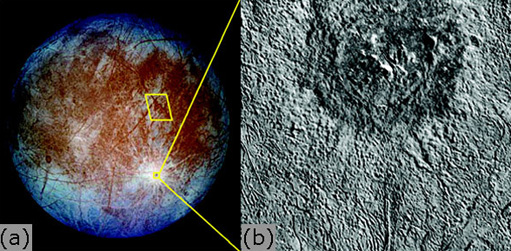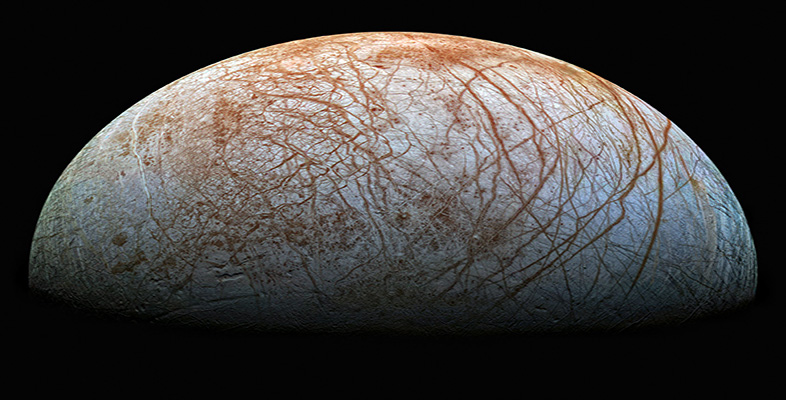2.3.2 The crater Pwyll
You might also have noted that there are no obvious impact craters visible in Figure 16 (see Section 2.3.1). In fact there are a few. One is a bright spot, 15 km in diameter, surrounded by a dark halo of ejecta that occurs 10 mm from the top edge and 65 mm from the left-hand edge of the figure. Another is a slightly larger pale feature with a discernible central peak 20 mm from the top edge and 45 mm from the right-hand edge. The youngest large crater on Europa occurs at 26° S, 271° W, which is outside the area covered by Figure 16. This is shown in Figure 17, and is named Pwyll (pronounced 'Puh-hl' or 'Poo-eel', after a character from Welsh legend, Box 6). Pwyll is 26 km across, and has a dark floor and a halo of equally dark ejecta extending for about 8 km beyond its rim, which was presumably excavated from below the surface. Much brighter, finely fragmented ejecta in the form of discontinuous rays can be traced for more than 1000 km, and forms the bright region surrounding the crater in the global view in Figure 17a. It is the high visibility of its ejecta rays that shows Pwyll to be the youngest of Europa's large craters. Statistical arguments based on the likely frequency of comet impacts onto Europa suggest that Pwyll is very unlikely to be older than about 20 million years, and is probably about 3 million years old.

Box 6: Names on Europa and other satellites
In order to avoid duplication of the names of features between bodies, and to try to achieve consistency of nomenclature on each body, the International Astronomical Union has established a naming convention for each planetary body in the Solar System. Names on Europa are drawn from Celtic gods, heroes, and myths; people and places associated with the Europa myth; and place names from ancient Egypt.
The crater on Europa called Pwyll is a character from Welsh legend, who appears in the mediaeval collection of tales known as The Mabinogion.
By contrast, features on Io are named after gods and heroes associated with fire, sun, thunder and volcanoes, and also people and places associated with the Io myth and Dante's Inferno.
Incidentally, the Galilean satellites themselves and many of Jupiter's smaller satellites are named after mythological characters (of various genders and species) who, to put it delicately, became 'romantically entangled' with the god Jupiter.
Question 8
Look at the detailed image of Pwyll in Figure 17b. Does Pwyll have the three-dimensional shape that you would expect of a young crater?
Answer
Pwyll is circular in outline, which is to be expected, but its topography appears to be extremely subdued, even on this image that was recorded when the Sun was very low in the sky (to judge from the shadows in the surrounding area). The rim is very poorly expressed, and there is a cluster of central peaks rather than a single central peak such as you might expect in a crater of this size.
Expert analysis shows that most of Pwyll's rim is less than 200 m high, and that (unusually for impact craters) its floor is hardly any lower than the terrain outside. Opinion is divided as to whether the impactor responsible for Pwyll actually penetrated right through the ice, but all are agreed that the crater shows the hallmarks of an impact into relatively thin (about 20 km in thickness) and weak ice.
Thus the paucity of large craters on Europa indicates that its surface is young, and the subdued cross-sectional shape of many of those craters that do occur suggests that the ice was relatively thin when they formed.
